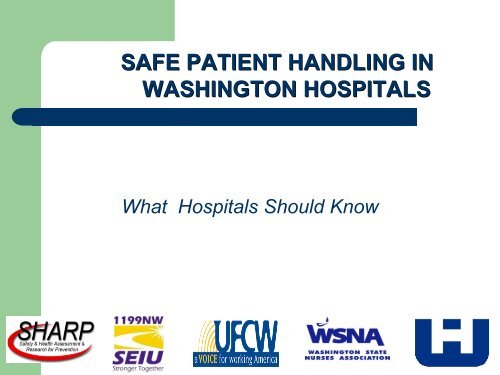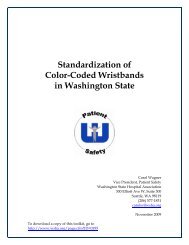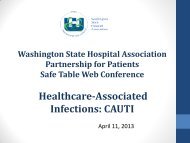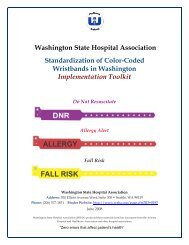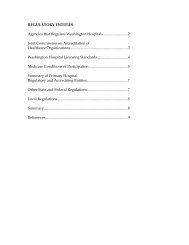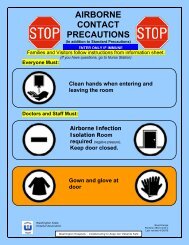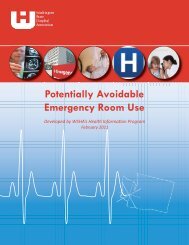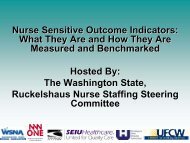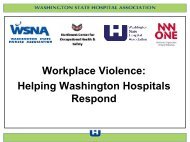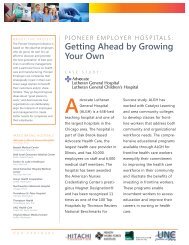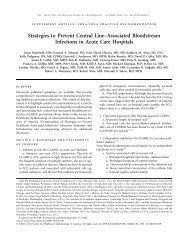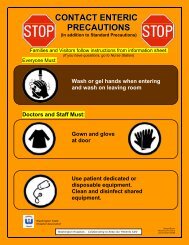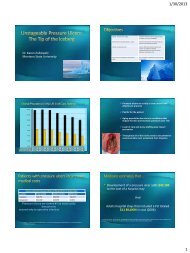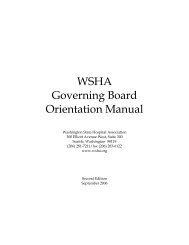Washington State Steering Committee Safe Patient Handling ...
Washington State Steering Committee Safe Patient Handling ...
Washington State Steering Committee Safe Patient Handling ...
Create successful ePaper yourself
Turn your PDF publications into a flip-book with our unique Google optimized e-Paper software.
SAFE PATIENT HANDLING INWASHINGTON HOSPITALSWhat Hospitals Should Know
Speakers• Brenda Suiter, Vice President, Rural and Public Health,<strong>Washington</strong> <strong>State</strong> Hospital Association• Leslie Pickett, PT, Ergonomics and Injury Specialist,Swedish Medical Center• Tim Kuzma, Director, Alpha Modalities• Ninica Howard, Senior Researcher, SHARP Program,<strong>Washington</strong> <strong>State</strong> Department of Labor and Industries
Outline• <strong>Safe</strong> <strong>Patient</strong> <strong>Handling</strong> Law & Background• Hazard Assessment• Equipment• B&O Tax Credit• <strong>Safe</strong> <strong>Patient</strong> <strong>Handling</strong> Program Evaluation• <strong>Safe</strong> <strong>Patient</strong> <strong>Handling</strong> Resources
<strong>Safe</strong> <strong>Patient</strong> Law & Background
<strong>Safe</strong> <strong>Patient</strong> <strong>Handling</strong> Legislation• Governor Gregoire signed Engrossed SubstituteHouse bill 1672 on March 22, 2006• Bill became law on June 21, 2006 (RCW 70.41.390)• Legislation makes safe patient handling part of howhospitals provide care by adding this requirement toDOH hospital licensing requirements
ESHB 1672:<strong>Safe</strong> <strong>Patient</strong> <strong>Handling</strong> LawIntent of the LawHow our law defines <strong>Safe</strong> <strong>Patient</strong> <strong>Handling</strong> :“The use of engineering controls, lifting and transfer aids, orassistive devices, by lift teams or other staff, instead ofmanual lifting to perform the acts of lifting, transferringand repositioning health care patients and residents.”
SupportersThe law was supported by:– Service Employees International Union Local 1199NW– United Food & Commercial Workers’ Union– <strong>Washington</strong> <strong>State</strong> Hospital Association– <strong>Washington</strong> <strong>State</strong> Nurses AssociationThe <strong>Safe</strong> <strong>Patient</strong> <strong>Handling</strong> <strong>Steering</strong> <strong>Committee</strong> wasdeveloped to provide tools and models that willhelp hospitals implement safe patient handlingprograms.
Why was the law enacted?• To reduce injuries and improve the safety ofhealthcare employees and patients• Provide funding to hospitals implementing safepatient handling programs• To improve nurse retention• To reduce costs to hospitals
What we know…• Hospitals have the highestrecordable injury rate of anyindustry with more than 100,000workers• There is no such thing as a safemanual lift of a dependent patient• <strong>Safe</strong> <strong>Patient</strong> <strong>Handling</strong> Programsare effective in reducing injuries
Law Timelines• February 1, 2007 – establish safe patient handlingcommittee with at least half of the committee beingdirect care staff• December 1, 2007 – implement safe patienthandling program• January 30, 2010 – acquire lifting equipment
<strong>Safe</strong> <strong>Patient</strong> <strong>Handling</strong> Program• <strong>Safe</strong> patient handling committee with 50% directcare staff: develop process for implementing SPHprogram• <strong>Safe</strong> <strong>Patient</strong> <strong>Handling</strong> Policy• <strong>Patient</strong> handling hazard assessment• Process to identify appropriate use of policy• Minimum amount of equipment necessary• Renovations must consider safe patient handlingequipment and storage• Train staff on policies, equipment and devices atleast annually
Hazard Assessment
RCW 72.23.390<strong>Safe</strong> <strong>Patient</strong> <strong>Handling</strong> Law• By Dec. 1, 2007 as part of the <strong>Safe</strong> <strong>Patient</strong><strong>Handling</strong> program the facility must “conduct apatient handling hazard assessment.Assessment should include:– <strong>Patient</strong>-handling tasks– Types of nursing units– <strong>Patient</strong> populations– Physical environments of patient care areas.
Risk Identifying & Control Process
Step 1: Analyze the Data• Examine your facility's injury data for:• When• Where• How• What• To WhomThe injuries occurred
Step 2: Identify the RisksWorkers’ Compensation Board of B.C. Handle with Care
Step 2: Identify the Risks• Physical Demands ofWork• Force• Repetition• Duration• Work Postures• Local Contact Stresses
Step 2: Identify the Risks<strong>Patient</strong> Populations:– Type of unit• ICU, Recovery,Neurology– Level of cognition –• Surgery, recovery,psychiatric– Weight of <strong>Patient</strong> –• Bariatric Units
Step 2: Identify the RisksWork Organization:• Variable work demands on different shifts– Organization of work flow• surgery schedules
Step 3: Assess the Worksite for Risks:Process design• Team members:– Physical / Occupational Therapists– Ergonomists– Nursing– Health and <strong>Safe</strong>ty– Industrial Hygienists Team members must be knowledgeable with the workenvironment, work activities and the physical demands ofthe work.
Step 3: Assess the Worksite for Risks:Process design• Size of team• Unit participation• Manager involvement
Step 3: Assess the Worksite for Risks:Process design• Variety of assessmenttools.• Tools vary in context foruse, variety of risk factorsand complexity of scoringsystem.• Impossible & impractical toinclude all variables in onetool.
Step 3: Assess the Worksite for Risks:Process designVariety of resources:– <strong>Patient</strong> Care Ergonomics Guide – VA– Work<strong>Safe</strong> B.C.– Royal College of Nursing Working Well Initiative– MAPO Index (Movement and Assistance of Hospital <strong>Patient</strong>s)
Step 3: Assess the Worksite for Risks1. Look for the risks2. Decide who might be harmed3. Assess the risk4. Record the finding5. Implement solutions
Step 3: Decide who might be harmed• Nurses• NAC’s• Physical andOccupationalTherapists• Sonographers• Transporters• Medical Imaging•Observe the high risk activities•Observe the physical environment•Interview workers
Step 3: Record Your Findings• Keep findings as objective and measurableas possible.• Provide documentation of findings.
Step 4: Implement Solutions• Engineering Controls• Work Practice Controls• Administrative Controls
Step 4: Implement Solutions• Formulate your recommendation• Involve the unit in your recommendations aswell as your safe patient handling committee.• Budget constraints /strategy
Swedish Medical Center RiskAssessment• E-mail letter to manager explaining process andrequesting time to schedule (2 hour process)• Memo for manager to give to staff to explain process• Before visit:– Equipment Survey– Pre-Site Visit Questionnaire
Swedish Medical Center RiskAssessmentSite visit: 2 hours‣ Opening Conference Interview: 30 Minutes‣ Front Line Staff manual handling questionnaire:30 minutes‣ Tour of unit : 15 minutes‣ Observation period (Ergonomics and <strong>Safe</strong>ty staff only): 30minutes‣ Closing conference (manager, ergonomics and safety only):15 minutes
Equipment
Lift Equipment Requirements of LawDeadline January 30 th 2010oror
Lift Teams• 24 / 7 availability• Team uses equipment, not manual lift.• Lift team members can have other roles in the hospital.• Should provide a rapid response to needs (scheduledand on call)
Equipment Requirements of Law‣ Must meet the addressed risks of the hazard assessment.‣ Must be easily accessible!
General Equipment Considerations• <strong>Safe</strong> for patients and staff to use– <strong>Safe</strong>ty features– Check product recalls• Ergonomically designed: 90% of population– Handles, weight, operation– Avoid creating “new injuries”• Easy and intuitive use of device / controls35
General Equipment Considerations• Addresses patient populationneeds:– Weight capacity– Special needs (cartransfers, gait training,limb holding)• Competitive warranty/ service• Local service / repairs36
Friction Reducing Device:Slider Sheets• Can be used for lateral slides,bed or chair repositioning andturning.• Washable or single usedisposable.• Need sufficient supply; can beissues with skin if left too long.• Handles helpful.37
Friction Reducing Device:Air Assisted Lateral Transfer Device• For lateral transfers or bedrepositioning• Two pieces: Air vacuum pumpand mat.• Wipe down or washable.• Needs electric plug in.• Can be left under patient(deflated) for up to 24 hours.38
Sit-To-Stand Device• <strong>Patient</strong> must have trunk control and some weight bearing ability onat least one lower extremity, be cooperative and understand andfollow simple commands.• Variation in sling operation: watch out for sling that rides up underarms.• Use with caution on: TKR, THR, unstable spine or severeosteoporosis.39
40Sit-To-Stand
Total Body LiftsUsed for:• Lateral transfers,• Bed chair transfers• Bed positioning / repositioning• Floor transfers (some models)• Limb holding/ wound care• Car transfers (specialized models)41
Total Body Lifts: Considerations• Foot print of device and space requirements for operation / storage.• Under bed clearance, compatibility with beds, stretchers etc.• Weight of lift / size of casters / push-pull factors.• Spreader bar fixed or removable – options on spreader bars• Scale option• Electric Listing – meets state / county / city codes• Batteries, proprietary or off-the-shelf• Slings attachment loop or clip – will manufacturer allow other slingsfrom other vendors• Weight capacity sufficient?42
Total Body Lifts
Ceiling Lifts• Same function as total body lift.• Gold standard for eliminating dependent lifts.• Convenient and quick compared to mobile lifts.44
Sling Options: Reusable vs. Single<strong>Patient</strong> UseReusable / Washable• Must have protocols in place for laundry & tracking• Require inspection before use• Mark date of first use on new slings• Understand warranty terms and conditions• Transfers: repositioning, seated, limb, ambulationSingle <strong>Patient</strong> Use / SPU• Three materials – paper/nylon, nylon, non-woven cotton• <strong>Patient</strong> specific – limited use, wash indicator tag• Transfers: repositioning, seated, limb support
SlingsTwo Types of attachment:•Clip or key design: limited in scopeto seated transfers.•Loop design: Universal – standardin industry•Wide variety of manufacturers,materials and functions‣Keep it simple!
47Ceiling Lifts
Ceiling Lifts: Rails•Rails are extruded indifferent thickness,typically thicker rails canspan farther with lesssupports. Use cautionin low ceilings.48•Rail compatibility –check that you havehoist options for thefuture.
Ceiling Lifts:Architectural Barriers49New Construction•Most cost effective•Multiple anchor options•Design incorporates curtains•At minimum, incorporate above ceilinganchorsRetrofit Construction•Barriers to install:–Limited anchor options–Seismic considerations–Odd room shapes–Sprinkler, curtain, light barriers–Census issues / noise–Door header transitions
Ceiling Lifts: Budget constraints50Portable Hoist Motors•SWL 200kg-272kg range•Solution for lower acuity rooms•Solution to address budget constraints•Solution as rentals for high census days•Storage is issueFixed Hoist Motors•SWL 200kg-500kg range•Ideal for high acuity areas•Ideal for bariatric rooms•Ultimate solution if funding is available
“Try before you buy”• Visit / talk with other facilities, especially when consideringceiling lifts• Contact vendor for trial use of equipment – designate a key unitin which staff will attend training and provide feedback.• Vendor Fairs / equipment rating by staff– Equipment comparisons– Staff input on rating and selection– Only include equipment needed and is within budget– Involve Bio-Med and Purchasing before bringing equipmentin.51
Vendor Agreements• Work with the vendor and agree to support levels for clinical andfacilities training – Get it in writing!• Warranty Policy – review written vendor policy to clearlyunderstand terms & conditions of warranty• Specialty items (slings, crossbars, etc.) – understand vendorpolicy on use of slings and crossbars from other manufacturers• Work with vendor to estimate cost to budget yearly formaintenance and repairs.• Work with vendor on obtaining cost for yearly serviceagreements after warranty period
Lift Installation: Team Effort• Facility Champion• Unit Manager• Project Manager• BioMed• Facilities– (construction/engineering)• <strong>Safe</strong>ty / Fire Officer• Facility Space Planning• Environmental Services• Linen
Law RequirementsNew Construction:“When developing architectural plans forconstructing or remodeling a hospital or a unit of ahospital in which patient handling and movementoccurs, consider feasibility of incorporating patienthandling equipment or the physical space andconstruction design needed to incorporate thatequipment at a later date.”
Stages of Architectural DesignProcessI. Master PlanningII.Programming – Functional DesignIII.Schematic Design – Functional ProgrammingIV.Design DevelopmentV. Construction DocumentsVI.Construction PhaseVII.Post Occupancy Evaluation
Ceiling Lift: New vs. Retrofit• Site Surveys• Architectural plans and lift plans to DOH.• Approval / Installation
57Swedish Orthopedic Institute
B&O Tax Credit
Business & Occupation Tax Credit• $10 million available in tax credits until December 30, 2010to pay for safe patient handling equipment.• $1,000 for each available acute care inpatient bed in thehospital.• Hospitals report acute care inpatient beds to Department ofHealth. 2007 data available at:– http://www.washingtonsafepatienthandling.org/images/Hospital_Inpatient_Available_Beds_FY2007.pdf• To claim the credit, hospitals must complete the Departmentof Revenue form available at:– http://www.washingtonsafepatienthandling.org/images/B_O_tax_form.pdf
B&O Tax Credit Usage Update• As of February 2009:– Approximately $6 million has been used– 67 hospitals have taken advantage of the credit– 24 (27) have met their individual cap• To find out what your individual hospital has done with the B&Otax credit and what you have left. Have your hospital’s B&O taxregistration number or UBI number and contact:Angie Green, Dept of Revenue(360) 902-7168
<strong>Safe</strong> <strong>Patient</strong> <strong>Handling</strong> ProgramEvaluation
Hospital SPH Program Evaluation• Under the law, hospitals must conduct an annual performanceevaluation of effectiveness of SPH program• Results are presented to the safe patient handling committee(both state and non-state funded)• Performance Evaluation includes:– The effect on patient-handling musculoskeletal disorder WC claims– The effect on lost work days due to patient-handling relatedmusculoskeletal disorders– Recommendations to improve the program’s effectiveness.
Where to find data?From your hospital• human resources or safety– OSHA 300 log– Workers compensation claims data– DOH/Joint Commission survey reports• For comparison purposes– Bureau of labor statistics (national data)– SHARP program (state workers compensationand survey data)
<strong>State</strong> Fund Hospital Evaluation• 18 Hospitals in <strong>State</strong> Fund qualify for the SPHpremium discount• To receive a discounted premium, they must:– Have a functioning SPH program (determined by L&I)– Report program evaluation results to L&I annually
Example: 2008 annual report fromsmall hospital in state fundoooooo<strong>Committee</strong>: list of members and positionsTraining: new employee orientation 1 st week equipment training andannual skills review process as well as computer basedInjury data 2008: 0 <strong>Patient</strong> <strong>Handling</strong> injuries or lost timeRisk Assessment: all for 2008 completedEquipment: assessment completed, staff discussion. Bought sitstandand slings, easy entry tub.Improvement Recommendations: Want to compare with otherhospitals to identify ways to improveNote: can compare your hospital to other state fund hospitals bycompleting SHARP SPH <strong>Committee</strong> survey and getting overallresults
Why Program Evaluations AreNecessary for <strong>State</strong> Fund Hospitals• Legislature is looking for hard outcomes – Reports dueDecember 1, 2010 & 2012• Equally important to know how hospitals are getting there isimportant to increase the likelihood of having favorable hardoutcomes.• Much of the process that needs to be in place and functioning isspelled out in the legislation.• Hospitals can compare themselves to other state fund hospitalsby completing SHARP’s SPH <strong>Committee</strong> survey and gettingoverall results
Resources
<strong>Safe</strong> <strong>Patient</strong> <strong>Handling</strong> Websites• <strong>Washington</strong> <strong>Safe</strong> <strong>Patient</strong> <strong>Handling</strong> <strong>Steering</strong> <strong>Committee</strong>– www.washingtonsafepatienthandling.org• Occupational Health & <strong>Safe</strong>ty Agency for Healthcare inBritish Columbia– www.ohsah.bc.ca• VISN 8 <strong>Patient</strong> <strong>Safe</strong>ty Center of Inquiry, Tampa– www.visn8.med.va.gov/patientsafety/center• National Institute of Occupational <strong>Safe</strong>ty and Health– www.cdc.gov/niosh/programs/hcsa
Special Thanks…• Steve Hecker, Director of Continuing EducationPrograms, UW School of Public Health andCommunity Medicine• Uzoma Mmeje, Research Assistant, <strong>Washington</strong><strong>State</strong> <strong>Safe</strong> <strong>Patient</strong> <strong>Handling</strong> ProgramDepartment of Environmental & Occupational HealthSciences
Q & AQuestions? Comments?


